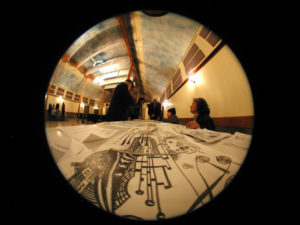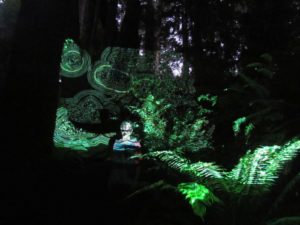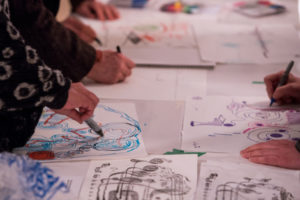Laboratorio Arts Society

LABORATORIO Arts Society is a nonprofit arts organization in Roberts Creek, two hours north of Vancouver. The brainchild of Giorgio Magnanensi, Artistic Director of Vancouver New Music, LABORATORIO Arts Society’s mandate is to foster artworks in which dialogues of various kinds can take place in real-time interaction.
Linda Bouchard interviewed Giorgio Magnanensi on November 21, 2017, at the offices of Vancouver New Music.
LB: For the past ten years, you have created unique events that involve the Sunshine Coast community. Tell us how you do it.

GM: One of our ongoing projects is called “Sound Garden.” It is an installation event that takes place on a summer night. The audience walks on a nature path that is most likely familiar to them. We use projection mapping on the boulders and the trees, and we embed sounds in the forest. The environment is delicately enhanced with small, hidden speakers playing skillfully augmented recorded sounds from the environment. The events are free to the public, and over two evenings, we usually have more than 170 people attending. This sound walk reveals new aspects of a familiar place and opens our senses in new ways. Because people are entering a familiar environment, they are willing to take a chance and experience something new.
LB: In your LABORATORIO Arts Society mission statement, you mention a “workshop for performers and audience.” Can you explain how you achieve this kind of experience?
GM: For the “One-Page Score” event, we ask people in the community with no prior musical experience to participate in creating a graphic score that is performed in public by professional musicians. It is a wonderful way to engage people in a creative process linking what we see and what we hear.
For the last One-Page Score event, we collaborated with Maurice Spira and Dean Schutz, two visual artists from the Sunshine Coast, and did a workshop experimenting with different techniques for creating graphic scores. We then invited 14 musicians, mostly from Vancouver, to come to Roberts Creek to interact and rehearse for a full day with nine community participants. The public performance that night at the Roberts Creek Community Hall was full (with about 170 audience members; free or by donation) and included projections of the performed score.
LB: How do you reach your audience in a rural community like Roberts Creek?
GM: We have built a mailing list over time, but we also use good old posters placed at local stores, the post office, at restaurants, and lots of word-of-mouth.
LB: You are a busy musician, composer, conductor, teacher, producer, and family man. Why is it important for you to pursue these activities?
GM: I live on the Sunshine Coast, and I want to foster activities that I love. In Vancouver, there is a lot going on, but here on the Coast, there are few community-engaging events—or at least not the kind of creative engagement I like to foster and present.
LB: Our new-music world can be very insular. In a way, we like to preach to the choir by performing for an expert audience. So, why do you feel the need to include people who might not know much about contemporary music?

GM: I believe art and music are not for the privileged few. I trust the power of sound and imagination, and I believe that my role as a musician is to foster dialogue and connection in a resounding energy around what I work with: sound.
People can be open to new ways of using sound if they are engaged, hands on, with the process. When working with live musicians, community members have the opportunity to be really close to sounds, with a visceral and intense response to that experience.
The goal of the “One-Page Score” is not to make great music. The most important aspects of the project are the process and to be engaged in creative activities through sound. I have to tell you that the audience at the last performance loved it—they wanted more, they wanted to participate. The combination of visual scores and live musicians provides a less abstract way for the audience of listening to sound and music.
LB: You are creating events that are participatory in some way and open to the community. From your website we see that you have offered workshops on Circuit Bending and other electronic activities. Would you choose to do a regular concert music series sometime?
GM: Yes, these activities are not exclusive. We have presented concerts at local venues. The name says it all: a Laboratorio!
